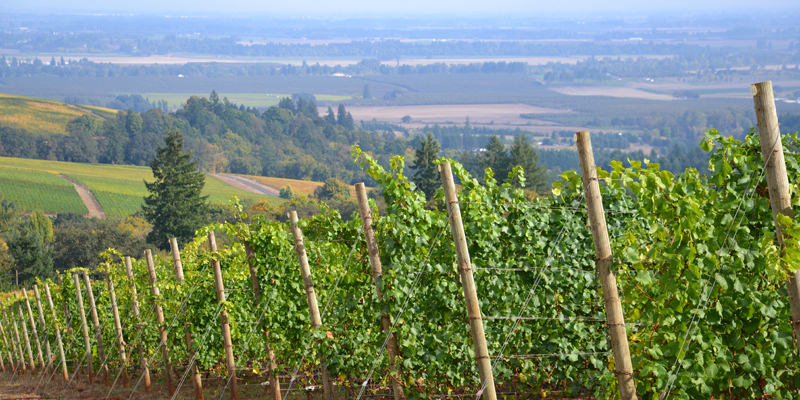Despite Oregon’s reputation as America’s world-class Pinot Noir region, the state makes a shockingly small amount of wine compared to its gigantic Southern neighbor, California. In part, that’s thanks to the Golden State’s colossal size and focus on agriculture, but its equally attributable to climatic differences. In the case of Pinot Noir, it’s a difference that’s easy to see, and taste in a glass-to-glass comparison of just a few wines. Plus, you can do it for under $40.
Pinot Noir is an ideal grape for making regional comparisons because of its delicate nature. Low-tannin and thin-skinned, it takes on the qualities of a region (or a winemaker’s signature) more easily than bold grapes like Syrah or Cabernet Sauvignon.
Oregon’s Willamette Valley, where the majority of the state’s wines are made, is roughly parallel in latitude to chilly Portland, Maine, and has a distinctly continental climate. Unlike the moderate, maritime climates of California’s Pinot Noir regions such as the Russian River Valley and the Central Coast, Oregon vines experience four full seasons with cold winters and hot summers. Even compared to California’s foggiest locales, Oregon sees less sunshine than most AVAs, which forces the grapes to ripen much more slowly than in other areas.
In the wines, this mild climate makes Oregon Pinots lighter in color, and more delicate in structure. California Pinots, which ripen easily thanks to California’s constant sunshine, tend to be darker and more purple in color (think about someone who lives by the beach vs. someone who just vacations there), and have riper, darker fruit flavors as a result.
For a great side-by-side comparison, we recommend classic Oregon 2013 Pinot Noirs from Argyle and Eyrie Vineyards, two of the Willamette Valley’s pioneers. Since the late sixties, these two wineries have been championing the grape in a restrained, Burgundian style that’s become synonymous with the Pacific Northwest. Usually delicate and earthy, these wines are light, soft, and fresh.
From California, we suggest the MacMurray Estate 2013 Central Coast Pinot Noir, a fruit-forward and nationally available bottling, as well as the Anaba 2013 Sonoma Coast Pinot Noir. Both the Central Coast and Sonoma Coast offer cool climates by California standards, with chilly nights contrasted by hot summer days. Arguably some of the state’s best Pinot Noirs—distinguished by ripe, luscious fruit and great acid—come from these AVAs.
In the glass, the color difference is striking. You’ll notice the MacMurray Estate is nearly purple in the glass, while the Arygle Nuthouse Pinot Noir is barely red and light enough to read through. While the Eyrie Pinot Noir is darker than its Willamette partner, it was still a bright currant tone compared with the deep red color of the Anaba.
On the nose, the differences were also noteworthy. Our panel (comprised of a writer, a sommelier, a winemaker, and wine-loving dietitian) found the Eyrie to be the most delicate, with soft red fruit aromas—like wild strawberries, currants, and cranberries—and lots of earthy, pine forest tones. The Anaba and MacMurray Estate, on the other hand, boasted bright, bold berry fruit aromas, and earthiness was a distinct undertone.
From start to long finish, the California wines were dominated by ripe red and purple fruit—plum, blackberry, and ripe cherry—and heavier in body than their Northern neighbors, but we were split on a favorite. With some foods, like delicate grilled salmon, we’d prefer a lighter, earthier wine like the Eyrie Pinot Noir, while with sliders or roasted pork, we leapt for the MacMurray Estate.
Cleary, there’s room across American menus and palates for every iteration of Pinot Noir, and with the wealth of climates on the West Coast alone there’s room for 1,000 comparisons. Don’t believe me? Try it this one at home and let me know what you think in the comments!

